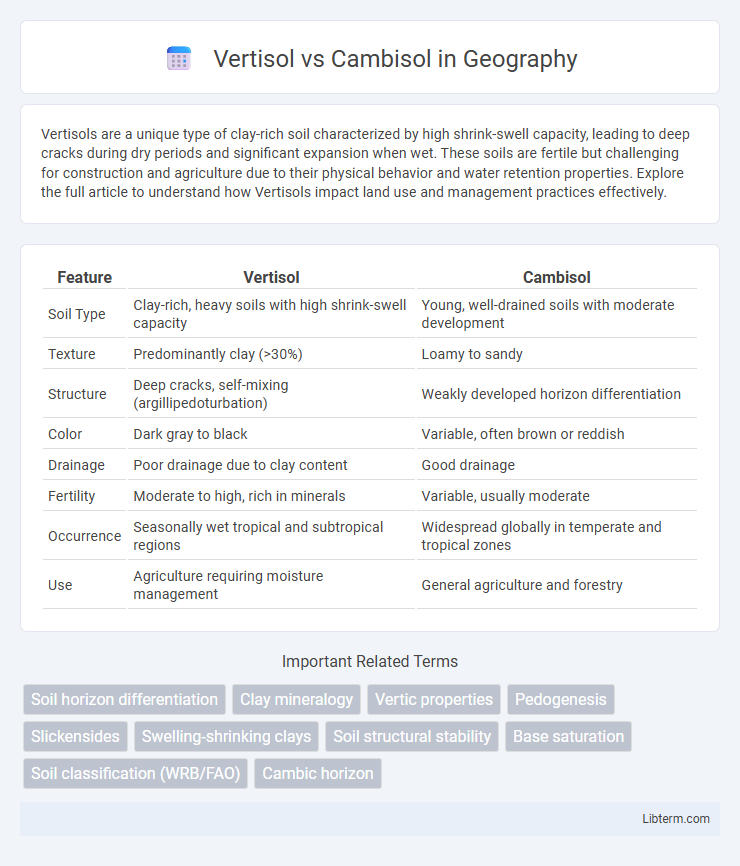Vertisols are a unique type of clay-rich soil characterized by high shrink-swell capacity, leading to deep cracks during dry periods and significant expansion when wet. These soils are fertile but challenging for construction and agriculture due to their physical behavior and water retention properties. Explore the full article to understand how Vertisols impact land use and management practices effectively.
Table of Comparison
| Feature | Vertisol | Cambisol |
|---|---|---|
| Soil Type | Clay-rich, heavy soils with high shrink-swell capacity | Young, well-drained soils with moderate development |
| Texture | Predominantly clay (>30%) | Loamy to sandy |
| Structure | Deep cracks, self-mixing (argillipedoturbation) | Weakly developed horizon differentiation |
| Color | Dark gray to black | Variable, often brown or reddish |
| Drainage | Poor drainage due to clay content | Good drainage |
| Fertility | Moderate to high, rich in minerals | Variable, usually moderate |
| Occurrence | Seasonally wet tropical and subtropical regions | Widespread globally in temperate and tropical zones |
| Use | Agriculture requiring moisture management | General agriculture and forestry |
Introduction to Vertisol and Cambisol
Vertisols are clay-rich soils characterized by high shrink-swell capacity, leading to deep cracks during dry periods and significant volume changes that influence land use and management. Cambisols exhibit a well-developed, but not heavily weathered, soil profile with moderate horizon differentiation and often support diverse vegetation due to their good drainage and fertility. Both soil types play crucial roles in agriculture and ecosystem functions, with Vertisols typically found in tropical and subtropical regions and Cambisols common in temperate climates.
Definition and Key Characteristics
Vertisols are clay-rich soils characterized by high shrink-swell capacity, causing deep cracks during dry periods and significant soil movement. Cambisols exhibit a well-developed subsurface horizon with signs of alteration or weathering but lack the extensive clay content and shrink-swell behavior seen in Vertisols. Vertisols are commonly found in lowland areas with seasonal moisture, while Cambisols occur in a variety of climates and are often fertile and suitable for agriculture.
Formation Processes of Vertisols
Vertisols form in clay-rich parent materials with high shrink-swell capacity, typically under seasonally wet and dry climates that promote the expansion and contraction cycles causing deep soil mixing and self-plowing. These soils develop through intense physical processes such as slickensides formation and churning, which disrupt soil horizons and result in a homogeneous profile. In contrast, Cambisols form through moderate weathering and eluviation processes, leading to the development of a distinct cambic horizon with less soil movement and mixing.
Genesis and Features of Cambisols
Cambisols develop primarily from weathered parent material in diverse climatic conditions, characterized by a mild horizon differentiation and significant biological activity influencing soil formation. These soils exhibit a cambic horizon with altered mineral structures, moderate texture, and good drainage, making them suitable for agriculture. In contrast, Vertisols form from clay-rich materials with high shrink-swell capacity, exhibiting deep cracks and self-mixing, which affects water movement and root penetration.
Physical Properties: Texture and Structure
Vertisols exhibit a clay-rich texture with a high content of smectite minerals, leading to significant expansion and contraction upon wetting and drying. This swelling behavior creates deep cracks and a self-mulching granular structure, enhancing soil aeration and root penetration. Cambisols typically possess a more balanced texture, ranging from loamy to sandy loam, with well-developed granular to subangular blocky structures that promote moderate water retention and good drainage.
Chemical Properties and Soil Fertility
Vertisols feature high clay content with significant amounts of smectite, leading to strong cation exchange capacity and nutrient retention, enhancing soil fertility despite challenges in aeration and drainage. Cambisols possess moderate clay levels with a balanced mineral composition, exhibiting lower cation exchange capacity but better structure and aeration, which supports moderate soil fertility suitable for diverse crops. The high base saturation and pH range in Vertisols contribute to nutrient availability, while Cambisols tend to have more variable pH and organic matter content influencing their nutrient dynamics.
Distribution and Occurrence Worldwide
Vertisols predominantly occur in regions with pronounced wet and dry seasons, such as parts of India, Australia, and the southern United States, where clay-rich soils expand and contract seasonally. Cambisols are widely distributed across temperate and tropical zones, commonly found in Europe, North America, and parts of Africa, characterized by their well-developed soil horizons and moderate weathering. The contrasting global occurrence of Vertisols and Cambisols reflects their formation processes, with Vertisols favoring heavy clay soils in low relief areas and Cambisols developing in diverse climates with varied parent materials.
Agricultural Suitability and Uses
Vertisols are heavy clay soils characterized by high shrink-swell capacity, making them fertile but challenging for cultivation due to cracking and waterlogging risks; they are ideal for crops like cotton, rice, and sorghum when managed with proper irrigation and drainage. Cambisols have a more balanced texture with better drainage and structure, supporting a wide range of agricultural uses including cereals, root crops, and horticulture. Vertisols require specific management techniques such as deep tillage and moisture regulation, whereas Cambisols offer greater versatility and ease of cultivation across diverse cropping systems.
Environmental Challenges and Management
Vertisols, characterized by high clay content and shrink-swell properties, often face water retention and erosion challenges that complicate sustainable land use and agriculture. Cambisols, with better drainage and structure, are less prone to waterlogging but may suffer from nutrient leaching and soil degradation under intensive farming. Effective management strategies for Vertisols include controlled drainage and organic amendments to improve soil stability, while Cambisols benefit from crop rotation and conservation tillage to maintain fertility and reduce erosion.
Summary: Key Differences Between Vertisol and Cambisol
Vertisols are clay-rich soils characterized by significant swelling and shrinking due to high smectite clay content, leading to deep cracks in dry seasons. Cambisols exhibit moderate weathering with a well-developed but non-accumulating mineral horizon, showing less structural change and better drainage compared to Vertisols. The primary differences lie in soil texture, moisture dynamics, and horizon development, impacting agricultural suitability and land use.
Vertisol Infographic

 libterm.com
libterm.com